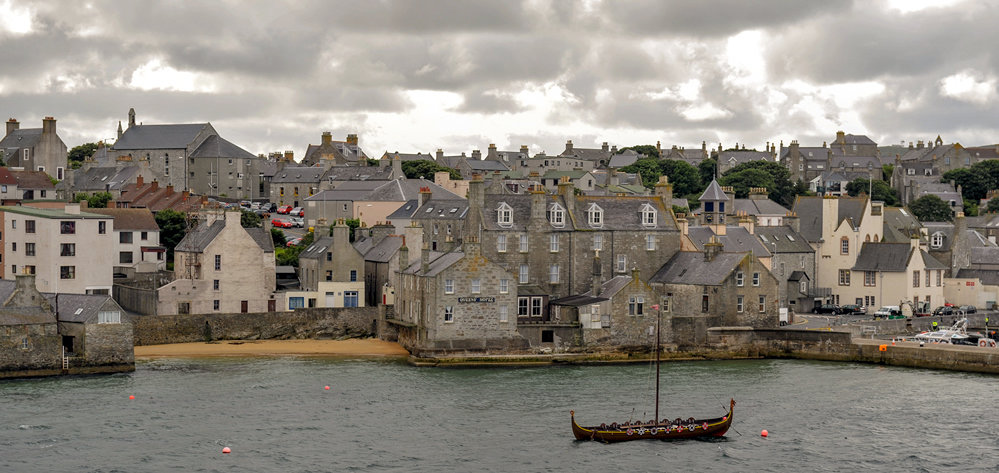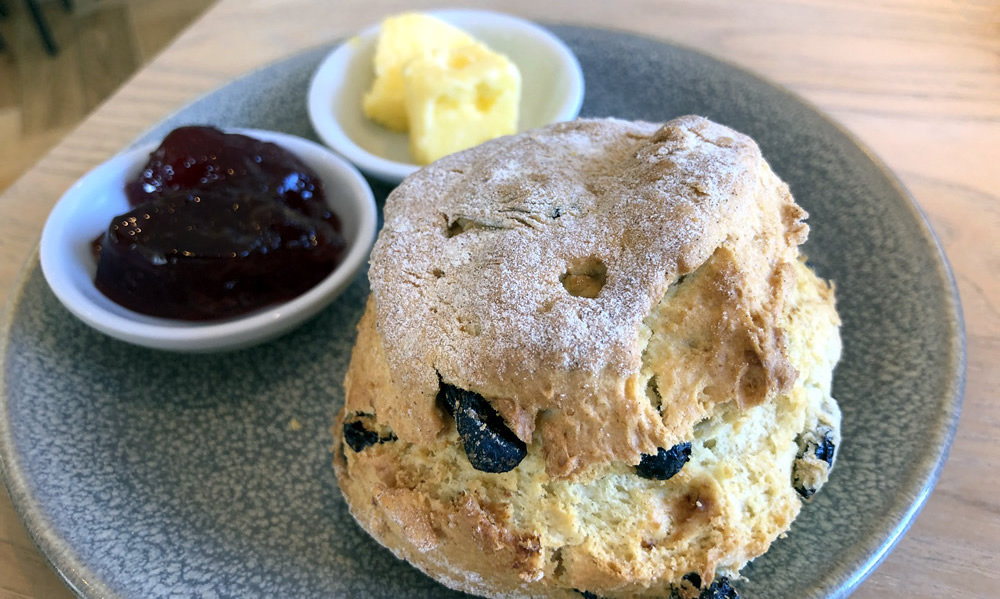Tasting Jewish nostalgia on the Shetlands
It was a standing-room only event last year, an amazing turnout. Young and old, locals and tourists, poured into the venue as part of my travels “back home” to the Shetlands. They came to hear my book talk and memories of growing up as part of one of the only Jewish families in the remote islands
The Greenwald name was respected throughout the Christian, G-d-fearing community. They came not just to hear a talk on kosher cuisine (mixed in with a dollop of nostalgia) but to share memories, still vivid, from more than 50 years ago.
The largest island, known as the “Mainland,” has an area of 373 square miles, making it the third-largest Scottish Island and the fifth-largest of the British Isles, according to general sources. There are an additional 15 inhabited islands. The archipelago is marked by an oceanic climate, a complex geology, a rugged coastline and low, rolling hills.
The “black oil” boom came in the 1970s. “Incomers” (those not born and bred there) flocked to Shetland to work on the oil rigs. From all races and religions, many with Jewish connections, they were attracted to life in a tranquil, rural environment. Thousands decided to stay. They were accepted and welcomed into the community of around 23,000 people. Some settled in the capital of Lerwick (population 7,000), off the north coast of mainland Scotland, while others put down roots in outlying islands.
Thanks to the sudden prosperity from the oil industry, the islands were connected by bridges and a roll-on/roll-off ferry. Together with Shetlanders, the incomers have assimilated and preserved a culture enriched by personal values — not unlike my family, the Greenwalds, Russian immigrants of the early 20th century.
As far as we knew, no other Jews had ventured to Shetland, although no doubt they would have been warmly welcomed by my Orthodox Jewish mother.
Jean Greenwald, our Ma, was a remarkable woman. She instilled a strong Jewish identity into her children under the most demanding of circumstances. Assimilating socially, she was a popular member of the community with many lifelong friends, but passed on a practical Judaic culture to her children through example and food. Candles were lit on Friday night and traditional dishes were cooked; nevertheless, she worked in the shop on Saturday. That was the busiest day of the week, when country folk came in to do their shopping.
Food was an essential element. While our neighbors were eating herring fried in oatmeal and a mealy currant pudding, the Greenwalds thrived on kosher fare, eating chopped and pickled herring and belly-warming kugels.
Diana Lubelska, with forgotten Jewish connections and married to a Polish husband, couldn’t imagine living anywhere else. She summed it up, saying, “I adore Shetland. The work and life balance is remarkable.” Susan Fogg lived and worked in Israel for 10 years before coming to Shetland 30 years ago.
Then there’s JeanAnne Charkham. Happily married to two Jewish husbands (and now widowed), she divides her time between London and a cottage in the village of Bigton. Her late husband arranged that “at the appropriate time” she will be buried next to him in the Reform Jewish cemetery in London. She remembers, “I never converted, but we respected each other’s values and lived so very happily together for 30 years.”
A young Jewish couple, Mimi and Eiten Reich of New York, decided to spend their honeymoon exploring Shetland. Why? Because of sheer adventure and curiosity that a Jewish presence existed in these remote islands.
The two August events, held in Lerwick, were sponsored by ScoJeC, the Scottish Council of Jewish communities. ScoJeC is the representative body of all the Scottish Jewish communities, an outreach to advance public understanding about the Jewish religion, culture and community. The Council also provides support for Jews in far flung communities such as Shetland. Dynamic Fiona Frank of ScoJeC working with librarian Marghie Thompson organized the events. Was the promise of free kosher buffet another attraction?
Fiona’s book, “Candles, Conversations and Class,” drew a packed audience eager to hear the story of her family, the Hoppensteins, who landed in Edinburgh in the 1880s. The book is impeccably researched illustrating generations of Jews, adapting to a new culture, assimilating or not.
And then there’s the food, the emphasis on fresh and local. The Greenwalds ate fish every day — an astounding variety, from herring to halibut, from sea to table within just a few hours. And Jean Greenwald transformed it all into healthy, delicious meals. She combined Ashkenazi dishes with good plain Shetland cooking. There was gefilte fish, the white fish chopped in a hand chopper clamped to the kitchen table, the finished fragrant balls never resembling the bottled variety, to haddock fillets simply simmered in milk and onions.
Eating as a tourist in the Shetlands can be challenging if you are strictly kosher. But fish is organic and plentiful, as are home-grown fruits and vegetables, even in the late-summer season, so it’s not impossible to pick and choose your way through local cuisine.
Almost 100 years ago, Shetlanders received my grandfather, Lewis Greenwald, and his sons with kindness and respect. They were the biblical “Chosen People.” Lewis and two sons, Hyman and Woolf, returned to Glasgow, where there was a Jewish community. Harry and Jean stayed. They were making a living, and Harry felt safe, far from pogroms, and had been quickly accepted. They became a vibrant part of the community, preserving their culture while instilling a strong Jewish identity in their children.
Today, these remote Shetland Islands are still a destination of tolerance and understanding, where all people are welcomed—no matter race, color, background or religion. And that is something increasingly hard to find in 21st century’s troubled world.
Here are two recipes from the old country.
Jean Greenwald’s Potted Herring (Pareve)
Serves 6
Ingredients:
3 large, fresh herrings, filleted (mackerel may be substituted for herring)
1 medium onion, thinly sliced
Salt and white pepper to taste
1 cup white vinegar
1/3 cup cold water
3 to 4 bay leaves
1/2 lemon, thinly sliced
Directions:
Preheat oven to 375 degrees.
Remove heads and tails from herring. Cut each fillet in half, lengthwise. Place a few slices onion on each. Sprinkle lightly with salt and pepper.
Roll up from tail end to head end. Set each roll on end in a casserole to hold rolls tightly together.
Mix vinegar and water. Pour over the herring.
Tuck in a few bay leaves and lemon slices. Cover loosely with foil.
Bake in preheated oven 30 minutes, or until fish flakes are opaque when separated with a knife.
Serve hot or cold.
Currant Scones (Dairy)
Makes 6 to 8
Ingredients:
2 tsp. vinegar
1 cup milk
2 cups all-purpose flour
5 tsp.baking powder
1/2 tsp.salt
5 Tbsp. butter or margarine
1/3 to 1/2 cup currants or raisins
Extra flour to pat out and dust baking sheet
Directions:
Preheat oven to 450 degrees.
In a small bowl, add the vinegar to milk. Let stand a few minutes. Do not stir. Milk will curdle. Dust a baking sheet with a little flour.
In a medium bowl, mix the flour, baking powder and salt. Cut in the butter or margarine until the mixture resembles breadcrumbs. Stir in currants.
Make a well in center. Add enough curdled milk to make a soft, slightly sticky dough. (The secret of a light scone is to have the dough just stiff enough to handle.)
Turn onto a well-floured board. Pat into a 1-inch thick round. Cut out scones using a 2-inch fluted cookie-cutter. To prevent sticking, dunk the cutter into flour.
Place on prepared baking sheet. Bake in preheated oven 12 minutes, or until lightly browned and raised.
Note: These are best when enjoyed as soon as possible. Leftovers can be wrapped in a clean towel; split and toast them after a day or two.
Ethel G. Hofman is a widely syndicated American Jewish food and travel columnist, author and culinary consultant.

 39.0°,
Fair
39.0°,
Fair 







